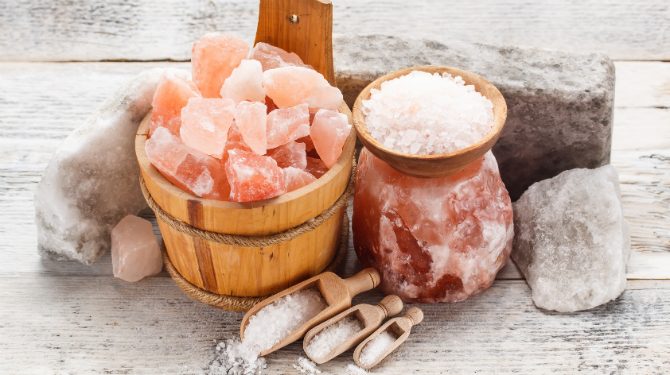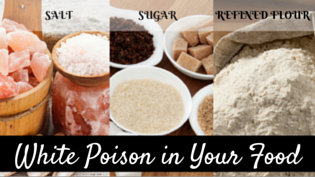
Know your salts - Rock, Table or Sea

Salts like sea salt and rock salt, which were once residing in the local banya and ration shops are now fast making their place the supermarket aisles and gourmet stores across the country. One major reason in their popularity, are the food networks where we see chefs sprinkling coarse crunchy salt bits into the recipes and we as viewers, are fascinated at the sight of the very ingredient we forget to give its due credit in our kitchens. Sea salt is preferred by food connoisseurs over table salt for its coarse, crunchy texture and stronger flavor. Another reason for their growing popularity is the demand for low sodium salts due to the fast growing incidence of hypertension in the urban masses.
With the different varieties of salt available today in the market, consumer are in a tizzy. An understanding of their source of origin shall provide some clarity in their selection.
The three basic types are: Table salt also known as the Refined salt, Sea Salt, and Rock Salt commonly known as Sendha Namak or Black Salt .
Sea salt is produced through evaporation of ocean water or water from saltwater lakes, usiually with little processing. And this is the reason why it contains certain trace minerals and elements. These minerals impart the mild flavor and color to sea salt, which also comes in a variety of coarseness levels. While on the other hand, Rock Salt is pure from nature, obtained from underground salt sediments formed by the drying up of salt water bodies, which have got covered by sediments over the years.
Table salt that we conventionally consume is typically a refined form of sea salt which is processed to eliminate impurities and minerals, and usually contains an additive to prevent clumping. It is also fortified with Iodine to maintain a healthy functioning thyroid gland. Iodine is required for formation of thyroid hormones, which help in growth and development.
Besides these, Himalayan salt is also a crude form of rock salt which is mined from the mountains of Himalayas in Pakistan and is fast grabbing attention due to its appearance and composition.
From health perspective, despite being the essence of salt consumption in our diets, it is infamous for contributing to the most common lifestyle disease of this era i.e., hypertension / high blood pressure, courtesy its sodium content. Most sea salts and table salt contain about 40 percent sodium by weight.
A recent scientific study by CASH (Consensus Action on Salt and Health, group of specialists concerned with salt and its effects on health in UK) has shown that sodium contents of salts from different sources is nearly similar and although the unrefined sea salt and rock salt has marginally lower sodium contents, the difference is not significant enough to patronize salt from one source over the other.
Doctors and health practitioners may be recommending sea / rock salt usage to the hypertensive and health conscious individuals, however there is a frustrating paucity of research to back this up. Existing literature and research points to the fact the mineral contents of the various salts are actually not a compelling reason to choose one salt over the other. These amounts really are negligible compared to what you get from food.
Think of it like sugar, i.e. an individual may not consume infinite amount of jaggery (good source of iron and other minerals) as it is a healthier alternative than refined sugar, likewise a one should not go overboard while consuming sea and rocks salts, simply because they have marginally lesser sodium contents and additional mineral supremacy over table salt. The key here is to consume salt (irrespective of its source) in limited amounts. The Dietary Guidelines for Indians recommend limiting salt intake to less than 6g a day. By avoiding processed foods and limiting the salt intake to 1tsp per day, one can easily attain the suggested levels and prevent salt associated health hazards.
Food connoisseurs amongst you, who have been lured by rock / sea salt for its sensorial (appearance, texture and flavor) aspects, need to remember that these are not fortified with iodine. Table salt has been fortified with iodine since the early 20th century as a simplest mode of introducing this essential mineral into the diets of a common man. In case you chose sea salt or rock salt over common salt, make sure you’re eating some other foods that are high in iodine, like fish, dairy, eggs and seaweed.
With growing food sensibilities, many of us are trying to reduce the amount of salt in our diet, and people are recklessly spending more money on 'premium' salt as these are believed to be healthier than traditional table salt. Instead, the cheapest - and healthiest - option would be to stop adding extra salt to food altogether. Moreover, since we our lifestyles have made us slaves of RTE foods, the need of hour is responsible food product development by manufacturers to reduce the amount of salt in their products.
P.S. Whatever, salt you decide to shake, remember to do it sparingly
Reference:
http://www.worldactiononsalt.com/less/how/other/index.html
“Comparison of salty taste and time intensity of sea And land salts from around the world” S.L. Drake, 2010, Journal Of Sensory Studies,Vol.26 (1),25-34


















